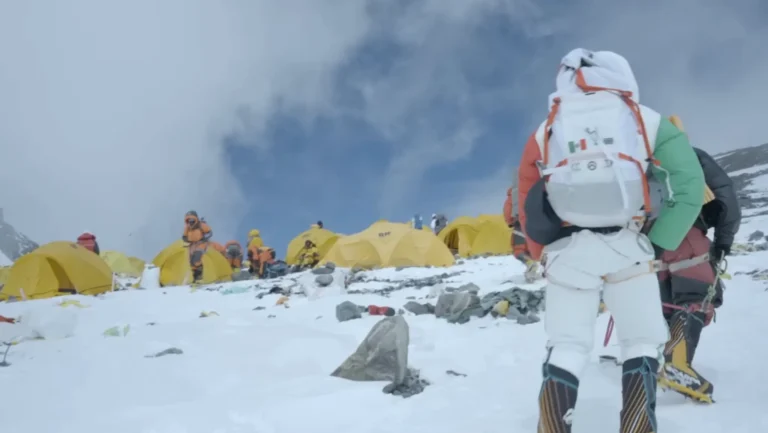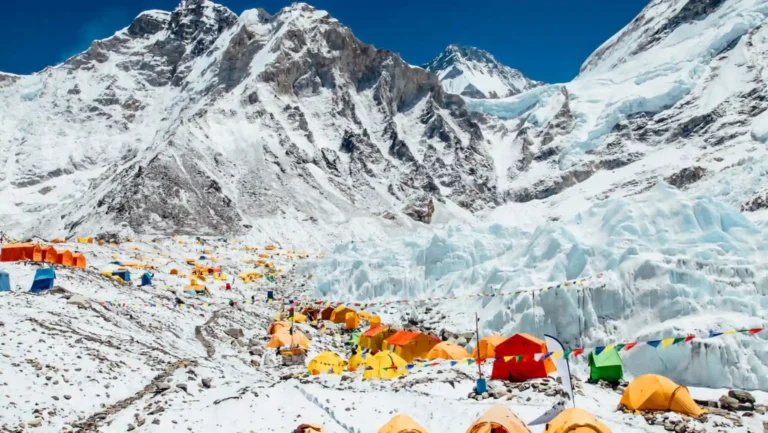Everest Base Camp (EBC) is one of the world’s most iconic trekking destinations, attracting thousands of adventurers each year. Nestled at 17,600 feet (5,364 meters), it serves as the gateway to the world’s highest peak, drawing thousands of mountaineers and trekkers. However, the journey to EBC is not just about breathtaking views and high-altitude trekking—it’s about survival in some of the harshest conditions on Earth.
With temperatures dropping below -20°C (-4°F) at night, powerful winds exceeding 50 mph, and the ever-present risk of snowstorms, having the right tent is crucial. Standard camping tents won’t provide the protection needed against EBC’s extreme weather, which is why trekkers and climbers require specialized Everest Base Camp tents designed for high-altitude conditions.
In this guide, we’ll walk you through everything you need to know about Everest Base Camp tents—from key features and types of tents to top recommendations for every budget and expedition style. Whether you’re an EBC trekker looking for a lightweight tent or an expedition team needing a durable base camp shelter, this in-depth guide will help you find the perfect tent for your adventure.
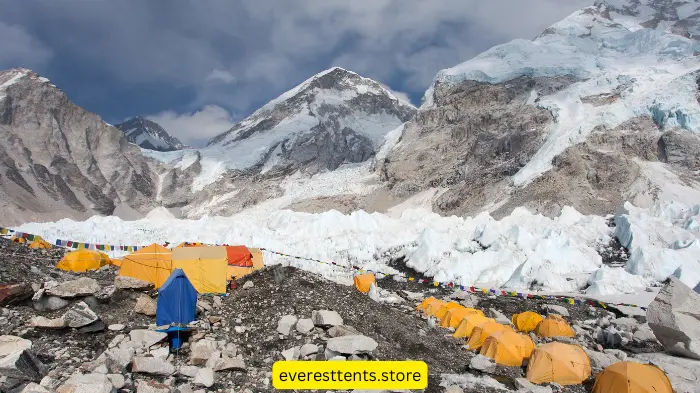
Everest Base Camp Conditions
Everest Base Camp (EBC) is one of the most extreme camping environments in the world. Sitting at 17,600 feet (5,364 meters), it serves as the final stop for trekkers and a crucial acclimatization point for climbers attempting to summit Mount Everest.
However, the high-altitude conditions at EBC are far from ordinary, and staying here requires proper preparation, especially when it comes to shelter.
If you’re looking for tents built specifically for extreme weather conditions, check out our blog post on Best Everest Tents for Extreme Weather.
What’s It Like at Everest Base Camp?
Unlike lower-altitude trekking camps, EBC presents unique weather challenges:
✅ Extreme Altitude – Oxygen levels at EBC are about 50% lower than at sea level, which can make basic activities feel exhausting.
✅ Freezing Temperatures – Nighttime temperatures can drop below -20°C (-4°F), even in peak trekking seasons.
✅ Harsh Weather Conditions – Strong winds over 50 mph, heavy snowfall, and sudden storms make it crucial to have a high-altitude survival tent that can withstand these conditions.
Why a Specialized Tent is Essential
Everest Base Camp Tent is not just a place to sleep—it’s your only protection against the elements. The wrong tent can expose you to extreme cold, discomfort, and safety risks. Here’s why a specialized four-season, high-altitude tent is a must:
✅ Protection from Harsh Cold & Wind Gusts – Insulated materials, reinforced poles, and a stable design help you stay safe and warm.
✅ Lightweight Yet Durable – Since trekkers carry their own gear, a tent must be strong enough for extreme weather yet light enough to transport.
✅ Insulation & Breathability – The right tent will trap warmth while allowing moisture to escape, preventing condensation buildup inside.
Staying at Everest Base Camp is a once-in-a-lifetime experience, but to enjoy it safely, you need a tent built for extreme weather.
In the next section, we’ll break down the different types of Everest Base Camp tents and which one is best for your needs.
Types of Tents Used at Everest Base Camp
Choosing the right tent for Everest Base Camp (EBC) depends on factors like weather resistance, weight, interior space, and breathability. While all tents used at EBC must be four-season tents, there are different types, each offering unique advantages.
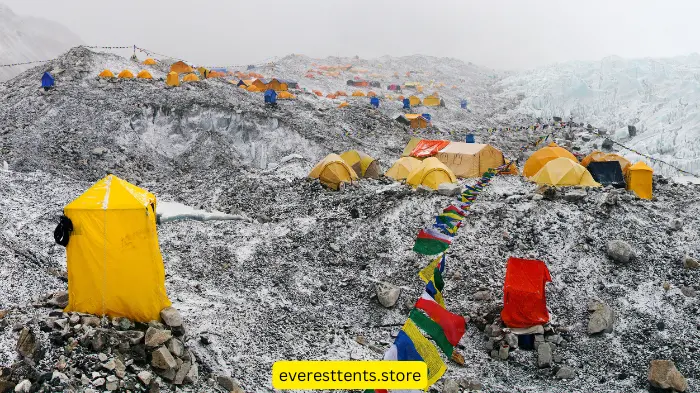
1. Dome Tents: Best for Solo Trekkers & Lightweight Setups
Dome tents are popular among solo trekkers and small groups because of their lightweight design and ease of setup. Their curved shape helps them shed snow and withstand moderate winds, making them a good choice for EBC trekkers who prioritize portability.
✅ Pros: Lightweight, easy to pitch, good wind resistance.
❌ Cons: Less interior space, not ideal for extreme storms.
🔹 Best For: Solo trekkers or those carrying their own tents.
2. Geodesic Tents: Best for Wind Resistance & Stability
Geodesic tents have multiple intersecting poles, creating a strong and stable structure that can endure high winds and heavy snowfall. These tents are widely used at Everest Base Camp and high-altitude expeditions due to their stability in harsh weather.
✅ Pros: Extremely wind-resistant, highly durable, suitable for extreme weather.
❌ Cons: Heavier than dome tents, more complex setup.
🔹 Best For: Trekkers and climbers staying at wind-exposed sites at EBC.
3. Tunnel Tents: Best for More Interior Space & Livability
Tunnel tents are known for their spacious design and are often used by larger trekking groups or for longer stays at base camp. Their elongated structure provides more headroom and vestibule space, making them a comfortable choice for extended expeditions.
✅ Pros: Spacious, excellent storage options, good weather protection.
❌ Cons: Requires proper anchoring, can struggle in extreme wind if not secured properly.
🔹 Best For: Groups or climbers staying at EBC for extended periods.
4. Single-Wall vs. Double-Wall Tents
Another important consideration is whether to choose a single-wall or double-wall tent:
| Feature | Single-Wall Tents | Double-Wall Tents |
| Weight | Lighter & easier to carry | Heavier but more protective |
| Breathability | Less breathable, prone to condensation | Superior ventilation & moisture control |
| Weather Resistance | Good for dry, windy conditions | Ideal for snow & extreme cold |
| Setup Time | Quick & simple | Takes longer to set up |
🔹 Best For:
- Single-wall tents: Trekkers who prioritize weight & speed.
- Double-wall tents: Those needing better insulation & moisture control.
Which Type Is Best for Everest Base Camp?
For most EBC trekkers, a geodesic or tunnel tent with a double-wall design is ideal for maximum wind resistance, warmth, and interior comfort.
However, for fast-moving solo trekkers, a lightweight dome tent or single-wall tent might be more suitable.
Key Features to Look for in an Everest Base Camp Tent
A tent designed for Everest Base Camp (EBC) isn’t just a shelter—it’s your primary defense against extreme cold, high-altitude winds, and heavy snowfall.
Choosing the wrong tent can lead to discomfort, poor insulation, and even safety risks, making it crucial to select a tent with the right features.
Below are the most important factors to consider when choosing a high-altitude survival tent for EBC.
✅ Four-Season Rating: Built for Extreme Cold, Wind, and Snow
At 17,600 feet (5,364 meters), temperatures at EBC can drop to -20°C (-4°F) or lower, with powerful winds exceeding 50 mph. Only a four-season tent can handle these harsh conditions.
🔹 Why It’s Important:
- Designed to withstand strong winds & snow loads.
- Features thicker fabrics & reinforced poles for durability.
- Provides better insulation than three-season tents.
💡 Tip: Look for expedition-grade four-season tents specifically built for high-altitude mountaineering.
✅ High-Quality Materials: Durability Matters
The materials used in a tent impact its strength, weight, and weather resistance.
🔹 Recommended Fabrics:
- Ripstop Nylon & Polyester – Lightweight, strong, and weather-resistant.
- Dyneema (Cuben Fiber) – Ultra-light and waterproof, but more expensive.
- PU or Silicone Coatings – Adds waterproofing & UV protection.
💡 Tip: Choose a tent with reinforced seams and waterproof coatings to prevent leaks and wear over time.
✅ Wind Resistance: A Must for High-Altitude Camping
Everest Base Camp experiences frequent high winds, making tent stability a top priority.
🔹 Key Features for Wind Resistance:
1. Aerodynamic Shape – Dome or geodesic designs prevent wind resistance.
2. Reinforced Poles – Aluminum or carbon fiber poles provide maximum strength.
3. Strong Guylines & Anchors – Secure the tent to prevent collapse in strong gusts.
💡 Tip: Use extra guylines and snow stakes to anchor your tent securely in windy conditions.
✅ Ventilation & Condensation Control
One of the biggest challenges at high altitudes is moisture buildup inside the tent. Condensation forms when warm air from your body meets the cold tent fabric, leading to damp gear and discomfort.
🔹 How to Prevent Condensation:
- Large Mesh Panels – Improve airflow without letting in cold drafts.
- Adjustable Roof & Side Vents – Allow moisture to escape while keeping heat inside.
- Double-Wall Design – Prevents direct contact with cold outer fabric, reducing moisture.
💡 Tip: Set up your tent with proper ventilation to balance warmth and airflow.
✅ Weight & Portability: Balancing Strength & Convenience
Since trekkers carry their own gear to EBC, choosing a lightweight yet durable tent is key.
🔹 Ideal Weight Ranges for EBC Tents:
- Solo Trekkers: 4-6 lbs (1.8-2.7 kg)
- Two-Person Teams: 6-9 lbs (2.7-4.1 kg)
- Expedition Groups: 10+ lbs (4.5+ kg)
💡 Tip: If you’re hiring porters or yaks, you can choose a heavier, more spacious tent for extra comfort.
✅ Vestibule & Storage Space: Keeping Gear Dry & Organized
A good vestibule (front porch area) is essential for:
1. Storing backpacks, boots, and trekking gear outside the sleeping area.
2. Keeping wet or snow-covered items separate from your sleeping space.
3. Providing a cooking & preparation area in extreme weather.
💡 Tip: Look for a double-vestibule tent if you need extra gear storage.
A four-season, high-altitude tent with strong materials, proper insulation, wind resistance, and good ventilation is essential for surviving & thriving at Everest Base Camp.
Choosing the right tent will keep you warm, safe, and comfortable, making your adventure more enjoyable.
Best Everest Base Camp Tents (Top Recommendations)
Selecting the right tent for Everest Base Camp is essential for staying warm, dry, and protected in one of the world’s most challenging environments.
Whether you’re a solo trekker, part of an expedition team, or looking for a budget-friendly option, the tents below are among the best options for Everest Base Camp.
Each tent is built to withstand extreme cold, high winds, and prolonged exposure to harsh conditions.
1. Big Agnes Guard Station 8 – Best for Large Groups & Expedition Teams
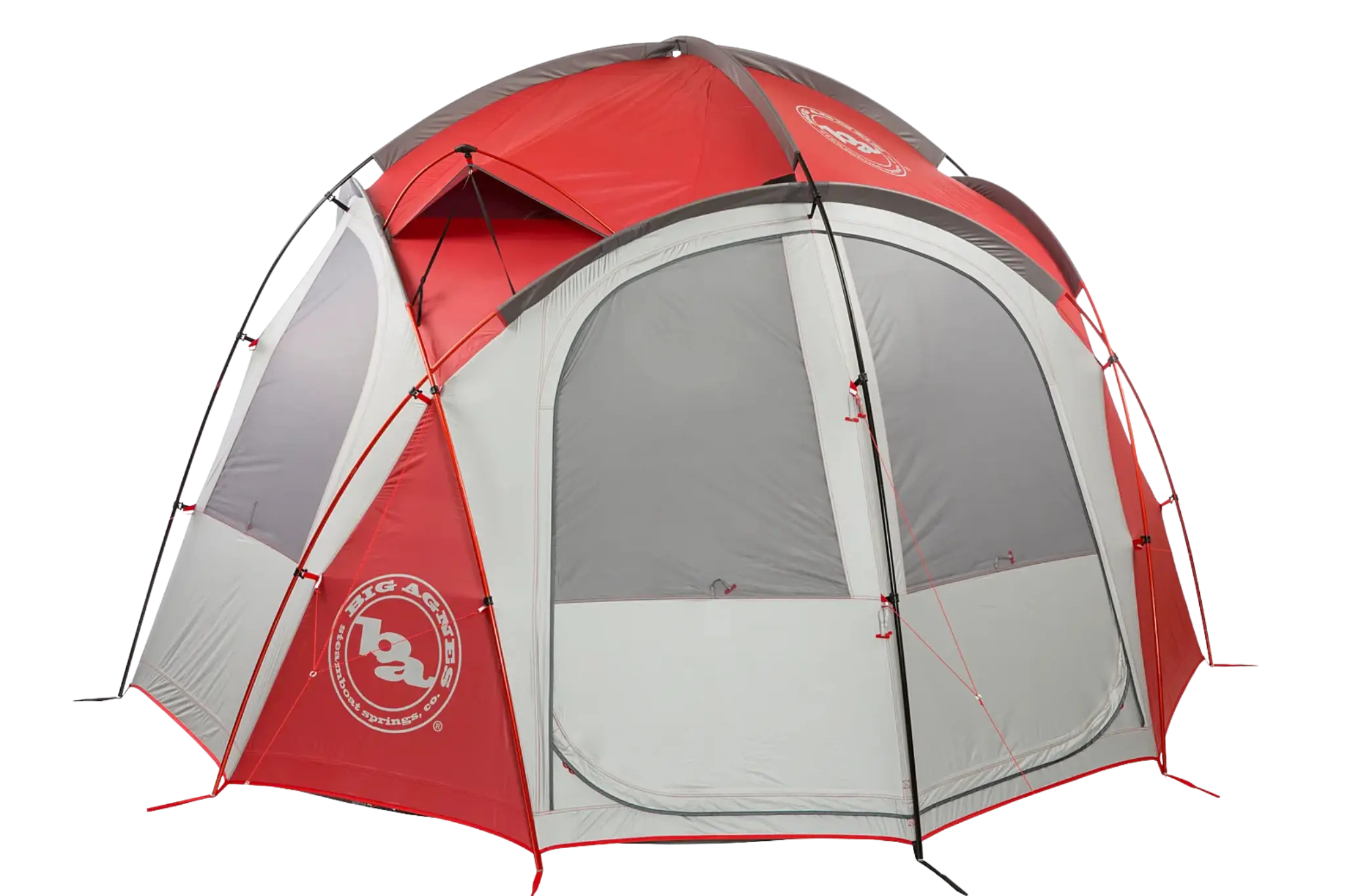
Why It’s Great:
The Big Agnes Guard Station 8 is a dome-style expedition tent built for the harshest alpine environments, making it a superb choice for Everest Base Camp.
It’s spacious enough to accommodate up to eight people, yet rugged enough to serve as a mess hall, medical station, or command center in extreme weather.
With a single-wall construction and an exoskeleton DAC pole system, this tent is designed for high-altitude functionality—quick to pitch, ultra-stable, and tough as nails in wind and snow.
Originally inspired by high-altitude Sherpa expeditions, this shelter blends mountaineering-grade performance with the livability required for extended stays at base camp.
It includes a removable floor, full footprint, and multiple vents and windows, ensuring comfort and airflow without sacrificing strength or warmth.
Key Features:
✅ Spacious 8-person capacity – Plenty of room for groups, guides, and gear.
✅ Stormproof Design – Withstands high-altitude winds, heavy snow, and extreme temperatures.
✅ Single-Wall Structure – Minimizes bad weather impact during setup.
✅ Durable Materials – Built with Dominico undyed ripstop polyester and DAC aluminum poles for maximum strength.
Pros & Cons
| Pros | Cons |
| ✅ Large capacity for groups & teams | ❌ Heavy (over 20 lbs), not ideal for trekkers carrying their own gear |
| ✅ Highly durable & stable in extreme weather | ❌ Requires a larger footprint for setup |
| ✅ Built with heavy gauge materials | ❌ Premium price due to expedition-grade materials and size |
2. MSR Access 2 U24– Best Lightweight Tent for EBC Trekkers
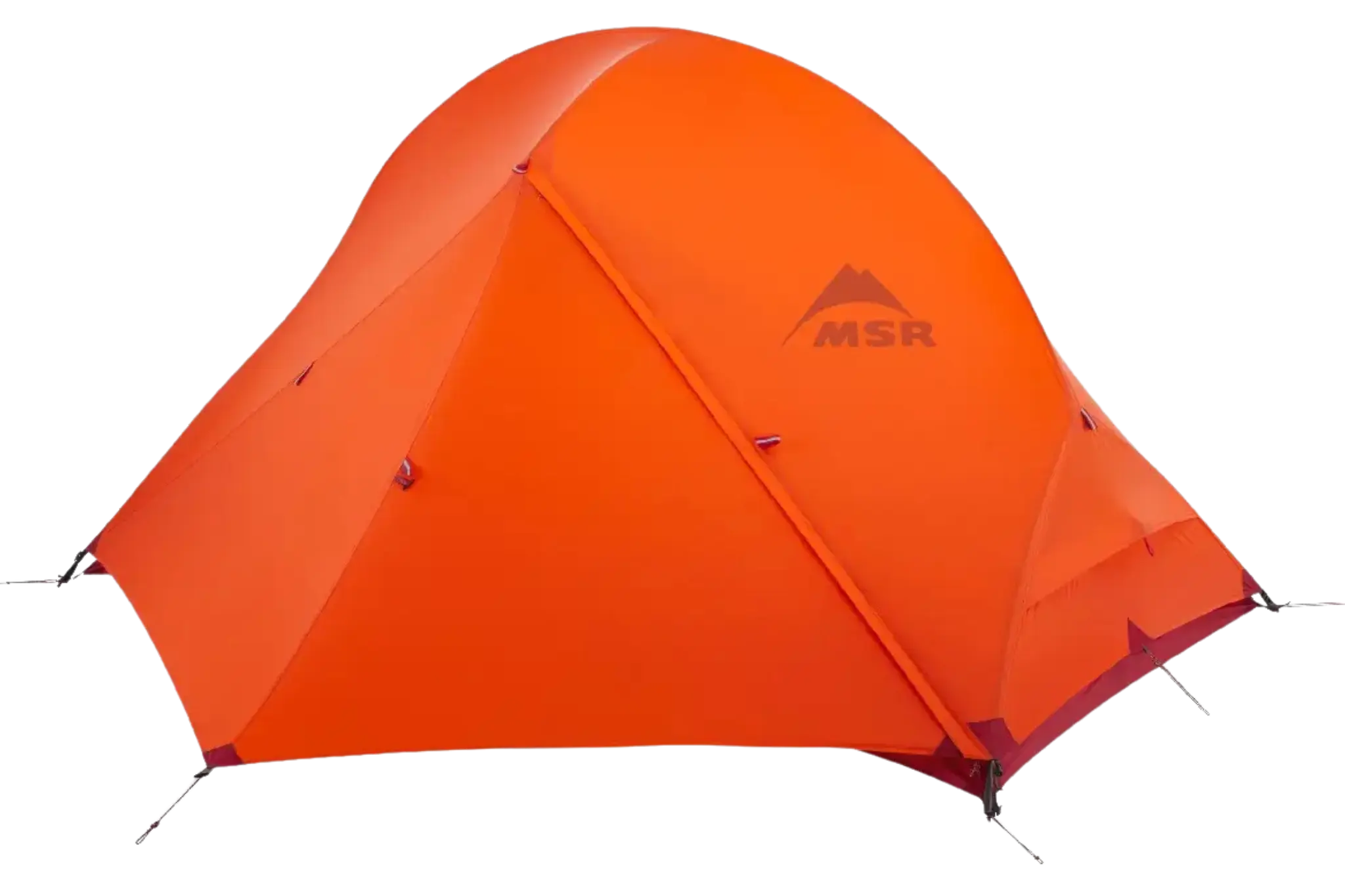
Why It’s Great:
For solo trekkers or small teams carrying their own gear, weight is a critical factor when selecting a tent for Everest Base Camp. The MSR Access 2 strikes a perfect balance between lightweight portability and high-altitude weather protection.
It’s not as heavy as full expedition-grade tents, yet it provides strong wind resistance and insulation for cold, unpredictable conditions at EBC.
Key Features:
✅ Lightweight for easier trekking – Weighs just 4 lbs 1 oz (1.8 kg), making it one of the lightest four-season tents.
✅ Easton Syclone Poles – Built to flex and resist breaking in high winds and snow loads.
✅ Four-Season Protection – Offers reliable warmth without excess weight.
✅ Compact & Easy to Set Up – Designed for quick pitching, even in bad weather.
Pros & Cons
| Pros | Cons |
| ✅ Lightweight & easy to carry | ❌ Not as durable as full expedition tents |
| ✅ Excellent wind & snow resistance for its weight | ❌ Less spacious for extended stays |
| ✅ Quick & simple setup | ❌ Small vestibules for gear storage |
3. Marmot Limelight 3P Tent– Best for Comfort & All-Weather Protection
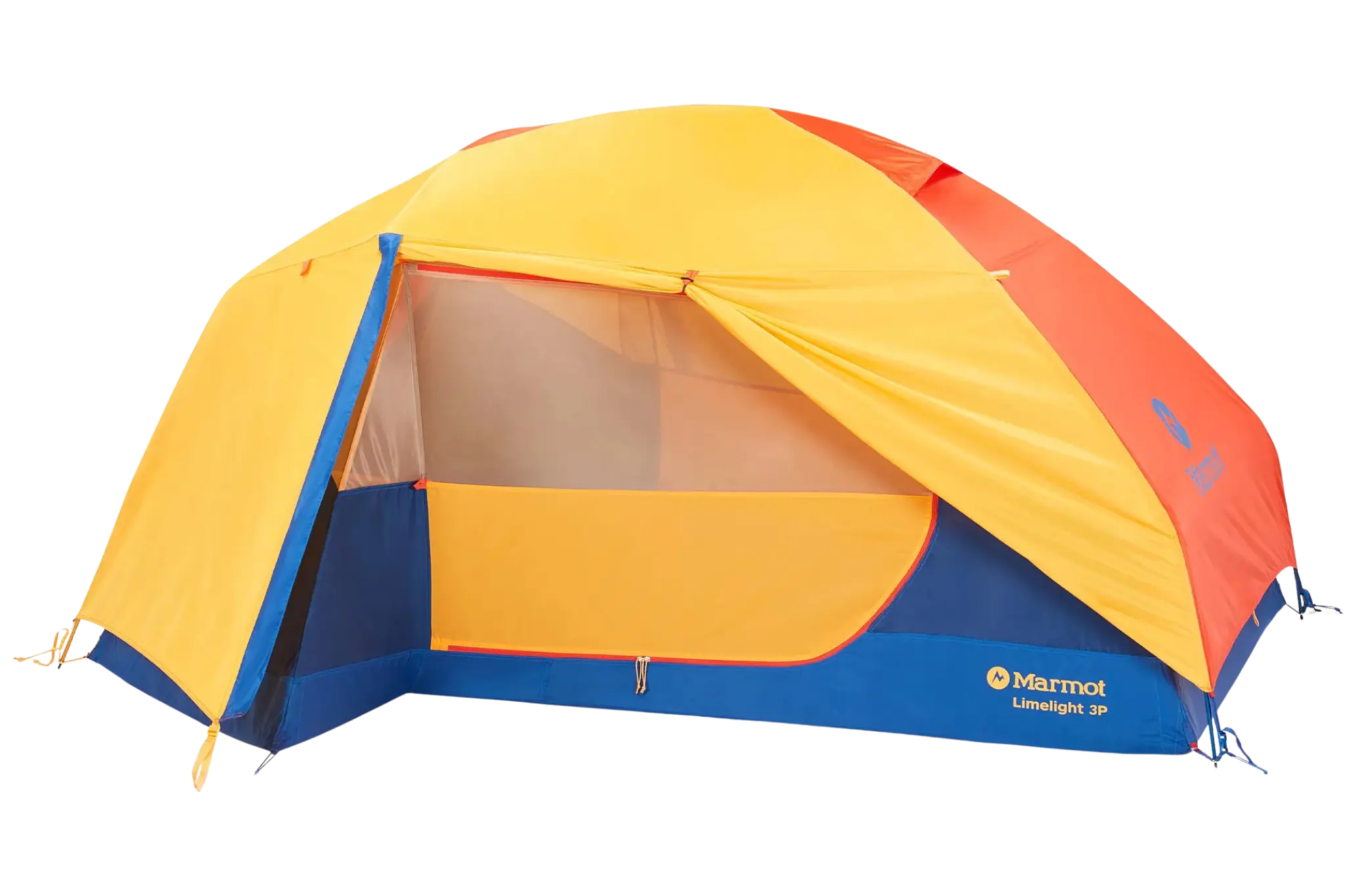
Why It’s Great:
The Marmot Limelight 3P is a rugged tent designed to withstand extreme weather conditions while providing ample interior space for trekkers at Everest Base Camp.
Its geodesic dome structure enhances stability in high winds and heavy snow, making it a reliable choice for mountaineering and base camp stays.
Key Features:
✅ Geodesic Dome Design: The DAC Featherlite NSL pole system provides maximum stability in extreme winds and snow loads.
✅ Roomy Interior: Offers comfortable sleeping space for 3 people with dual vestibules for gear storage.
✅ Weather-Resistant Fabric: Features fully seam-taped, Nylon Ripstop, Silicon/PU waterproof fly and floor for protection against rain and snow.
Pros & Cons
| Pros | Cons |
| ✅ Excellent wind and snow resistance | ❌ Heavier than ultralight trekking tents |
| ✅ Large vestibules for extra gear storage | ❌ Takes slightly longer to set up |
| ✅ Spacious and comfortable for extended stays | ❌ Premium price point |
4. Black Diamond Fitzroy Tent – Best for Compact Strength in Harsh Alpine Conditions
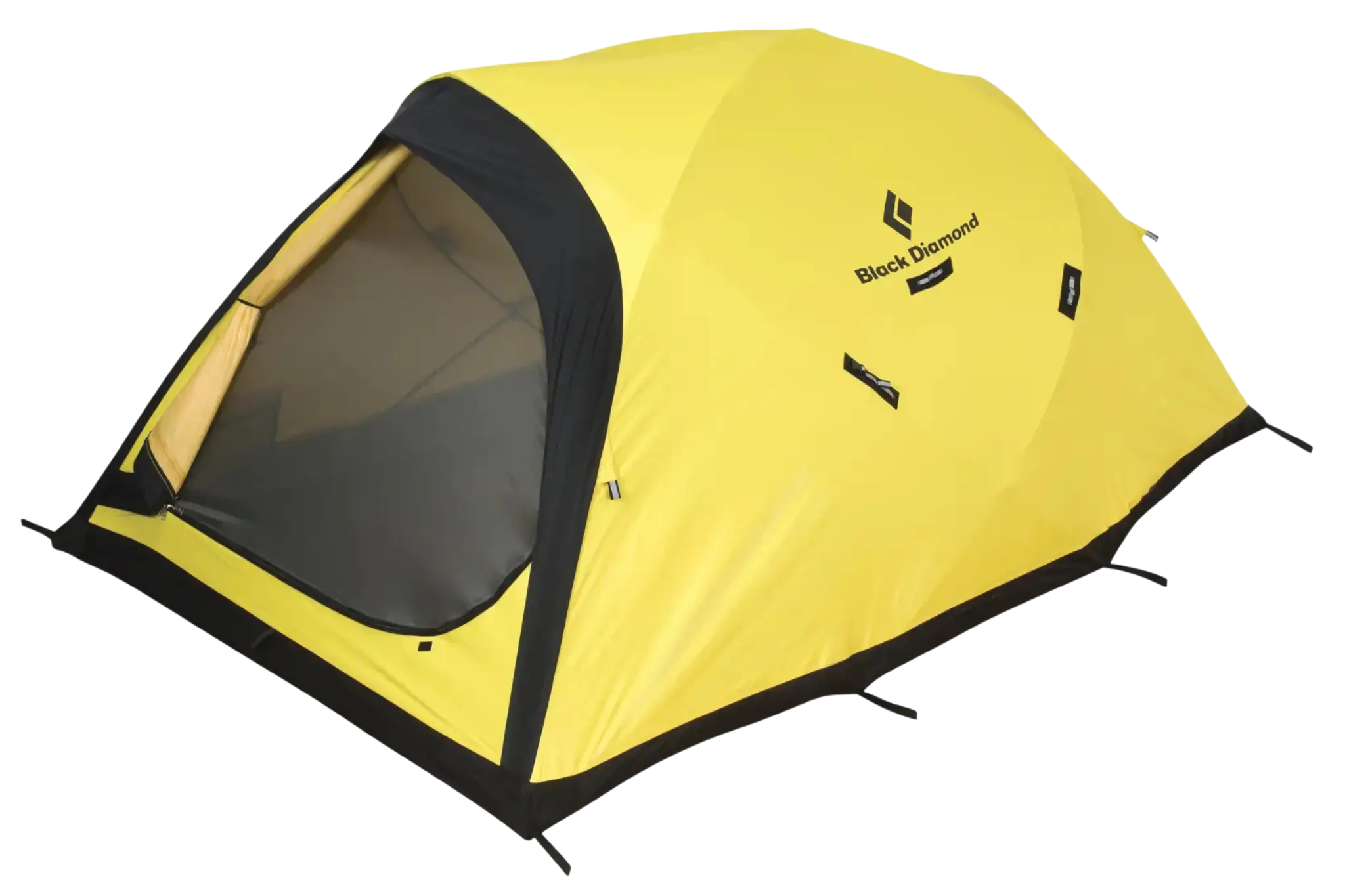
Why It’s Great:
The Black Diamond Fitzroy Tent is a high-performance, 4-season, 2-person shelter built for serious alpine missions. Its steep-sided, four-pole design not only offers enhanced stability in brutal weather but also maximizes interior space for added comfort at high altitudes.
Made from ToddTex single-wall fabric, this tent is designed to handle snow, wind, and condensation, making it a solid choice for climbers trekking to Everest Base Camp or any high-altitude environment.
Weighing in at just over 6 pounds, the Fitzroy strikes a rare balance between strength and packability. From steep slopes to windy ridgelines, it’s trusted by mountaineers who need reliable protection in a minimal footprint.
Key Features:
✅ Steep-Sided, 4-Pole Structure – Maximizes headroom and resists wind and snow buildup
✅ ToddTex Single-Wall Fabric – Waterproof, breathable, and seam-taped for full weather protection
✅ Dual Doors with Vents – Features internal mesh panels and pole-supported awnings for ventilation
✅ Compact & Lightweight – Packs down to 5 x 19 inches and weighs only 6.25 lbs for alpine mobility
Pros & Cons
| Pros | Cons |
| ✅ Durable single-wall ToddTex fabric resists moisture and wind | ❌ No built-in vestibule (vestibule sold separately) |
| ✅ Steep walls maximize interior space for two | ❌ Single-wall design requires venting discipline to avoid condensation |
| ✅ Lightweight and compact for high-altitude climbs | ❌ Premium price point for its category |
5. ALPS Mountaineering Lynx 2 – Best Budget Option for EBC Trekkers
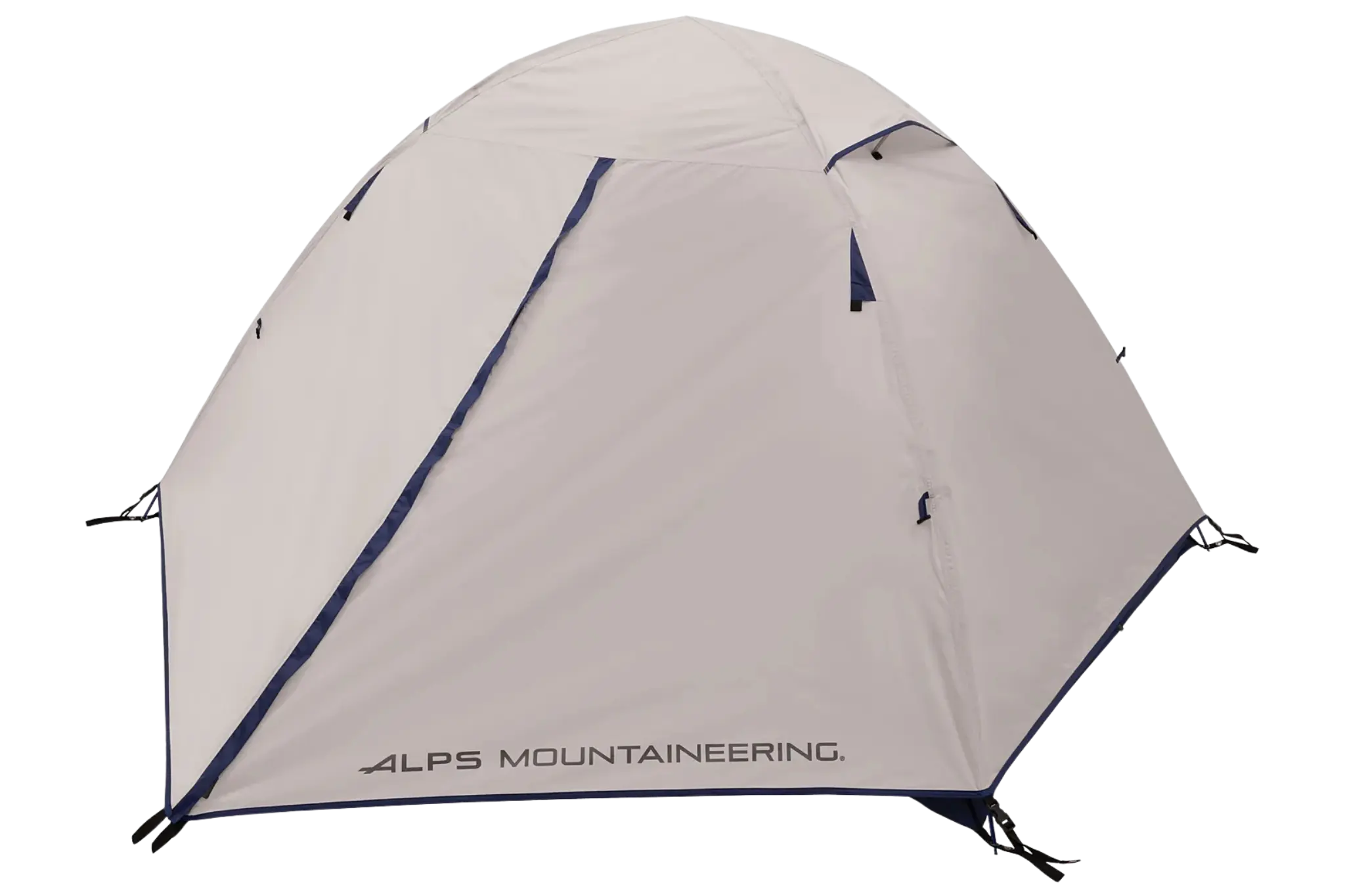
Why It’s Great:
For budget-conscious trekkers heading to Everest Base Camp, the ALPS Mountaineering Lynx 2 offers solid four-season protection at an affordable price.
While it’s not a full expedition-grade tent, it provides good insulation, ventilation, and storm resistance for those who want a reliable tent without spending a fortune.
Key Features:
✅ Affordable four-season tent – Provides decent protection at a budget price.
✅ Lightweight & Easy to Set Up – Weighs just 5 lbs 12 oz (2.6 kg), making it a good option for independent trekkers.
✅ Weatherproof Design – Comes with factory-sealed seams & waterproof coating to keep moisture out.
✅ Decent Wind Resistance – Aluminum poles & guy-out points offer moderate stability.
Pros & Cons
| Pros | Cons |
| ✅ Budget-friendly for a four-season tent | ❌ Not as durable as high-end expedition tents |
| ✅ Lightweight & easy to set up | ❌ Less stable in extremely strong winds |
| ✅ Waterproof design for moderate snow & rain | ❌ Smaller vestibules for gear storage |
The right tent for EBC depends on your needs—whether you need a large expedition tent, a lightweight trekking tent, or a budget-friendly alternative.
How to Set Up Your Tent at Everest Base Camp
Setting up a tent at Everest Base Camp (EBC) requires more than just pitching it on flat ground. The high altitude, freezing temperatures, and unpredictable weather demand careful placement, secure anchoring, and proper insulation to stay warm and protected.
Here’s how to correctly set up your tent at EBC for maximum comfort and safety.
✅ Finding the Right Spot
Choosing the right location is the first step in ensuring a stable and secure tent setup.
- Avoid Low-Lying Areas – Snow and water tend to accumulate in depressions, leading to cold spots and moisture buildup inside your tent.
- Look for Natural Wind Barriers – Set up near rock formations or ice walls to help shield against strong winds.
- Check for Stability – Ensure the ground is firm and level before pitching your tent to prevent sinking or tilting.
💡 Tip: If camping in deep snow, compact the snow with your boots before setting up your tent to prevent sinking overnight.
✅ Securing the Tent Properly
The high winds at Everest Base Camp can easily blow away an unsecured tent, so anchoring it correctly is crucial.
- Use Snow Stakes – Regular stakes won’t hold in snow, so use longer, wider snow stakes to anchor your tent.
- Reinforce with Rocks – Place heavy rocks over guylines and tent corners for extra stability.
- Tighten Guylines & Use Multiple Anchor Points – This reduces movement in strong winds and helps maintain the tent shape.
💡 Tip: Bury stakes or guylines in the snow and let them freeze in place for extra security in windy conditions.
✅ Weatherproofing Your Setup
To keep your tent warm, dry, and protected, take extra steps to weatherproof your setup.
- Close All Vents in High Winds – Prevents snow from blowing inside.
- Use a Snow Skirt (if available) – Blocks wind from entering underneath the tent.
- Check Ventilation – Proper airflow is critical to reducing condensation inside your tent.
💡 Tip: Open small vents near the top of the tent to allow moisture to escape without letting in too much cold air.
✅ Tips for Staying Warm & Comfortable
Even with a four-season mountaineering tent, staying warm at EBC requires the right gear and setup.
- Use an Insulated Sleeping Pad – A high-quality R-value sleeping pad prevents heat loss to the frozen ground.
- Layer Your Sleeping System – Use a -20°C or colder-rated sleeping bag with thermal liners for added warmth.
- Keep Your Gear Dry – Store wet clothing & boots in the vestibule to avoid moisture buildup inside the tent.
- Hydrate Before Sleeping – A warm drink before bed helps regulate body temperature in freezing conditions.
💡 Tip: Sleep with your water bottle inside your sleeping bag to prevent it from freezing overnight.
A properly set-up tent is your best defense against extreme cold, strong winds, and unpredictable conditions at Everest Base Camp.
Finding the right location, securing your tent properly, and using smart weatherproofing techniques will help you stay warm, dry, and comfortable throughout your trek.
FAQs About Everest Base Camp Tents
Trekking to Everest Base Camp (EBC) requires the right gear, and choosing a proper tent is one of the most important decisions. Below are some frequently asked questions to help you understand what to expect when camping at Everest Base Camp.
How heavy should my Everest Base Camp tent be?
The weight of your tent depends on whether you are carrying it yourself or using porters/yaks for transport.
- Solo Trekkers: 4-6 lbs (1.8-2.7 kg) – Lightweight but must handle cold.
- Two-Person Teams: 6-9 lbs (2.7-4.1 kg) – More durable with added space.
- Expedition Groups: 10+ lbs (4.5+ kg) – Larger tents for extended base camp stays.
💡 Tip: If you have porters or yaks, you can opt for a more spacious and insulated tent without worrying about extra weight.
How do I prevent condensation inside my tent?
Condensation is a common issue at high altitudes due to temperature differences inside and outside the tent.
✅ Ways to Reduce Condensation:
- Use adjustable vents & mesh panels for airflow.
- Avoid breathing directly into your sleeping bag—moisture gets trapped inside.
- Keep wet gear in the vestibule to prevent extra moisture inside the tent.
💡 Tip: Open a small vent near the top of your tent to allow moisture to escape while keeping heat inside.
Are rental tents available at Everest Base Camp?
Yes, rental tents are available at Everest Base Camp and in trekking lodges along the route. However, there are some limitations:
✅ Pros of Renting a Tent:
- Saves weight—no need to carry a tent during your trek.
- Some expedition companies provide fully set-up base camp tents.
❌ Cons of Renting a Tent:
- Quality may not match high-end expedition tents.
- Rental tents may be heavily used & less insulated.
- Limited availability, especially during peak seasons.
💡 Tip: If you’re joining a guided expedition, check if they provide base camp tents before bringing your own.
Selecting the right tent for Everest Base Camp is crucial for staying warm, dry, and safe in harsh conditions. Whether you bring your own tent or rent one at base camp, ensure it’s a four-season, well-insulated tent with strong wind resistance.
Conclusion
Choosing the right tent for Everest Base Camp is one of the most important decisions for trekkers and climbers.
The extreme altitude, unpredictable weather, and freezing temperatures at 17,600 feet (5,364 meters) require a four-season mountaineering tent that provides proper insulation, wind resistance, and durability.
Whether you’re a solo trekker needing a lightweight option, part of a small team, or an expedition group requiring a spacious shelter, selecting the best tent will ensure a safer and more comfortable experience.
To help you find the best high-altitude tents for Everest Base Camp, we’ve compiled top-rated recommendations based on performance, durability, and user experience. Explore our top picks now and gear up for your next Everest adventure!
💬 Have questions about Everest Base Camp tents? Drop a comment below or ask for recommendations—we’re here to help! If you’ve trekked to EBC before, share your experience and let others know what tent worked best for you. Happy trekking!
